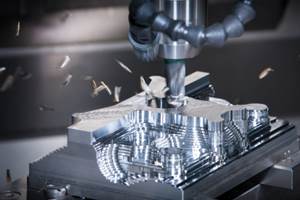Design vs. Manufacturing — Can We All Just Get Along?
The relationship between these two basic departments is critical to the success of any manufacturing company.
Product-producing companies tend to compartmentalize their departments, and the two most basic departments in any such company are those focused on design and manufacturing. All production begins with design engineering, where assemblies and component workpieces are conceived. Design data then are provided to manufacturing, where component workpieces are manufactured and products are assembled.
Manufacturing-related departments include at least four major areas. Manufacturing engineering is where manufacturing processes are planned. Quality control is where control plans are created to ensure that acceptable workpieces are produced. For companies that have CNC machine tools, the programming department is where CNC programs are developed. And the shop floor, of course, is where all manufacturing processes are performed.
All manufacturing-related departments are directly affected by the design department, although, in most companies, manufacturing engineering acts as a buffer for the shop floor. Indeed, manufacturing costs are simply a reflection of design engineering methods.
In my 40-plus-years’ experience in and around manufacturing companies, the most severe pitfalls I have witnessed are in poor relationships between design and manufacturing. The majority of companies I have visited experience at least some productivity-killing consequences in this regard.
The impact on productivity of this rift ranges from distracting to crippling. When people in these two critical departments are not on the same page, the result is always a total manufacturing cost that is higher than it should be. At best, workers in each area do not completely respect those in the other, and they may constantly challenge or demean the other’s work. This results in ill feelings all around and can easily escalate into something much worse.
The rift usually begins with bickering and finger-pointing as problems crop up. Design people commonly believe that manufacturing people should be better/smarter/faster than they are—better able to interpret design methods. Manufacturing people may believe that design people should provide clearer/more consistent/simpler information on their drawings. Or they may believe that specifications are more precise than necessary, resulting in manufacturing processes that are more elaborate or expensive than they need to be.
This kind of rift tends to escalate with time, as do the related issues. Employees in each area may eventually refuse to work with those in the other department, and may eventually try to disrupt or even sabotage work done by the other.
In the worst situations I have witnessed, the company's management favors one side or the other, and does not make objective decisions when disputes arise. In some privately owned companies, for instance, the owner may have started the company after having designed its first products. He or she may not fully understand or have an enthusiastic interest in the actual manufacturing of the products. This kind of owner may commonly side with design engineering, even though this may result in increased manufacturing costs.
Eliminating the rift can be difficult. Sides have been chosen, and an us-versus-them attitude probably permeates the company. Since this rift can result in an excessive total manufacturing cost, especially if the company operates in a highly competitive field, eliminating the rift could mean the difference between survival/profitability and bankruptcy.
The key to a better working arrangement is mutual understanding. People on both sides must accept that those on the other are doing their best, and they must try to understand the related problems/issues. In my experience, the rift boils down to two basic issues:
1. Manufacturing workers do not appreciate that design engineers are often under great pressure to produce new designs quickly in order to attract new business. This makes it difficult for them to respond to issues that arise on the shop floor, since it distracts the designers from what they consider the more important task of creating new designs.
2. Design workers do not appreciate the impact that their designs have on manufacturing costs. Primary concerns include the precision of specifications (tolerances that may be smaller than necessary), inconsistent methods of dimensioning/tolerancing and inadequate notification when revisions are made.
It will take one person who oversees both departments to draw the two groups together. Since design and manufacturing are the two most basic departments in any company, this will have to be a very high-ranking person. And when the two sides cannot work things out on their own, this person must be able to make objective decisions that workers in both areas will respect and to which they will adhere.
Related Content
How to Reduce Cycle Times by 70% and More on Your Existing CNCs and Dramatically Improve Tool Life Too
By employing advanced high efficiency milling techniques for the entire machining routine, SolidCAM’s iMachining technology can drastically reduce cycle times while vastly improving tool life compared to traditional milling.
Read MoreKey CNC Concept No. 1—The Fundamentals Of Computer Numerical Control
Though the thrust of this presentation is to teach you CNC usage, it helps to understand why these sophisticated machines are so important. Here are but a few of the more important benefits offered by CNC equipment.
Read More6 Steps to Take Before Creating a CNC Program
Any time saved by skipping preparation for programming can be easily lost when the program makes it to the machine. Follow these steps to ensure success.
Read MoreUnderstanding The Four Major Behavioral Styles
Companies today are expanding the role of teams in the workplace in an effort to empower employees and improve organizational effectiveness. The more we try to work as a team, the more important it becomes to recognize that people exhibit different behavioral styles.
Read MoreRead Next
The Cut Scene: The Finer Details of Large-Format Machining
Small details and features can have an outsized impact on large parts, such as Barbco’s collapsible utility drill head.
Read More3 Mistakes That Cause CNC Programs to Fail
Despite enhancements to manufacturing technology, there are still issues today that can cause programs to fail. These failures can cause lost time, scrapped parts, damaged machines and even injured operators.
Read MoreObscure CNC Features That Can Help (or Hurt) You
You cannot begin to take advantage of an available feature if you do not know it exists. Conversely, you will not know how to avoid CNC features that may be detrimental to your process.
Read More
.jpg;width=70;height=70;mode=crop)

























